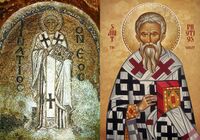Fourth Council of Constantinople (Catholic Church)
The Fourth Council of Constantinople (Catholic Church) event was a distinctively odd gathering of the Christian church in 869-870. Hardly anyone turned up for the discussion which was about whether a Pope in Rome had the power to prevent the Byzantine government in Constantinople choosing their own patriarch if the Papacy objected The original dispute had centered around the deposition of Patriarch Ignatios in 858 by Byzantine emperor Michael III on the grounds that 'he smelt funny'[1]. Michael had then installed his favourite amateur theologican Photios instead.
Photios[edit]
This had eventually led to the 'Photian schism' as Rome refused to recognise the new Patriarch of Constantinople. The non-recognition extended to otherwise staunch supporters of the Orthodox church who had stayed loyal to the exiled Ignatios. They pointed out that Photios had been 'catapulted' into the top job in a rapid career advancement that took five days worth of religious ordination and finally enthronement as patriarch.
At first there was the regular flow of messages back and forward between Rome and Constantinople. Pope Nicholas I and Patriach Photios remained in contact to see if the split could be reconciled. Since it often took at six months for the post to get to either city thanks to the violent deaths of messengers in the hands of bandits and pirates, things were further complicated by the need to translate letters from Greek to Latin and the other way round. Often these translations were inaccurate and would leave everyone confused. Rome's non-recognition of Photios and their continued adherence to the exiled Ignatios eventually led to a full blown schism. Pope Nicholas announced he had 'sacked Photios' in his position as Supreme Pontiff. Ignatois was the rightful patriarch.
There became a hardening of positions. Rome claimed their right to rule supreme on these matters as their Christian mandate of authority came from Jesus via St. Peter. Constantinople said the apostles and the churches they founded were all co-equals with Rome. Photios then added in another unresolved issue about how the Holy Spirit travelled from God and Jesus or God via Jesus. The former position had become an article of faith in the Western Christendom but not in the Eastern half. Finally Photios received support from the other patriarchies based in Alexandria, Antioch and Jersualem to condemn Pope Nicholas as a 'heretic' for adding stuff into the official Christian creed without agreement with his brother big cheeses.
Change of government[edit]
The issue remained unresolved but then there was a change at the top of the imperial government. Emperor Michael III was assassinated by his former friend Basil the Horse Jockey who became Basil I. Wary of Photius the new ruler came up with the idea to ally with Rome against Photios. To settle the issue (when did that ever solve anything in Christian theological disputes), emperor Basil wrote to Pope Adrian II who had succeeded the 'heretic Nick'. Emperor Basil deposed Photios and brought back Ignatois. To make sure this seemed a 'regular way of doing things', Basil called for a church council to be held in his capital.
The only substantial issue to discuss was whether Photios had been rightly removed. No one came forward to support the deposed patriarch. The other issues were about icon adulation (yes) and kissing holy paintings/mosaics of Jesus (yes again). This was a call back to the earlier dispute over iconoclasm which the Byzantine empire had twice argued about with foul language and sharp swords. What wasn't discussed was the issue about God + Jesus = Holy Spirit or God via Jesus = Holy Spirit. Perhaps it was getting late and everyone there refused to reopen that debate again. By the end of the council meeting attendance had picked up sharply. Something to do with free holy wafers is suggested.
Return of Photios and Numbering[edit]
Though Photios had been deposed as patriarch he got a job as tutor for the imperial brood of Basil. Photios was therefore at hand to succeed Patriarch Ignatios when the later died of old age in 877. This time emperor Basil didn't object to a restoration of Photios and indeed called the Fourth Council of Constantinople (Eastern Orthodox) to re-affirm the state of affairs. This council condemned any more 'mucking around' with the Holy Spirit business. It was back to God > Jesus > Holy Spirit. May you receive poisonous spiders down your vestments if you supported the other position. Since Rome sent representatives to this council who approved of this result, it meant Rome was apparently in support of both views of how the Holy Spirit moved about between the divine and the divinely inspired.
To help confuse historians both this council and the one held ten years later in the same city are both called 'Constantinople IV'. Like getting on the right train, check the indicator boards to see if you're on the Catholic train to paradise or the Orthodox one. Your soul will apparently depend on it.
See also[edit]
| Preceded by: Second Council of Nicaea |
Christian Councils 869-870 |
Succeeded by: Great Schism |



